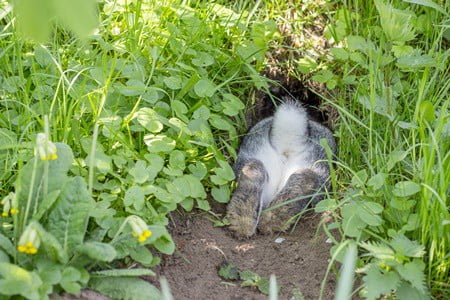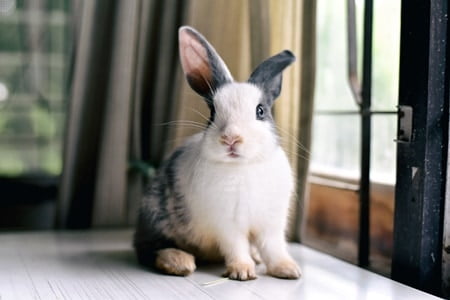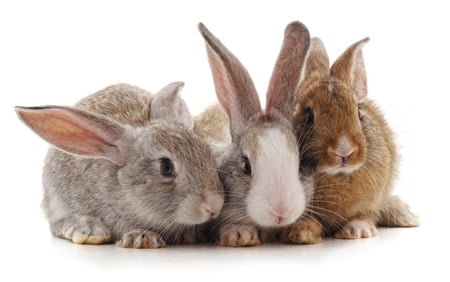Your rabbit may be breathing too fast, mouth-breathing, showing increased respiratory effort, or releasing a nasal discharge. Understanding a rabbit’s respiratory system enables you to understand if everything is normal.
Rabbits are obligate nasal breathers, which means that they have the physical necessity to breathe through their nose and not their mouths. Nose breathing also allows rabbits to eat while they breathe.
Rabbits breathe much faster than humans. The normal respiration rate of an adult rabbit is 30 to 60 breaths per minute. Some rabbits may breathe more quickly, especially if they’re feeling stressed or overheating.
Breathing Process in Rabbits
The rabbit’s nasal cavity (inside of the nose) is situated dorsal to the mouth. Between the mouth and the nasal cavity is the hard and soft palate. The roof of the mouth is the palate. The hard palate is the front region of the roof of the mouth and the soft palate is the back part.
The nasal cavity is also divided into a left side and a right side with a cartilage barrier in the middle. The inside of the nose is covered with fine hairs that clean entering air by collecting dust before the air enters the respiratory tract.
At the entrance of the nostrils, rabbits have sensory pads that make the nose sensitive to touch. When completely relaxed, the nostrils remain still. But their nostrils can twitch up to 150 twitches per minute.
Rabbits twitch their noses because it exposes their noses to more air and moves the scent-detecting organs in their nostrils. This allows them to catch even the smallest bit of scent in the air.
When a rabbit breathes, it’s alar folds open up to allow air to flow through the nostrils. The air then moves into the nasal cavity, down through the trachea and the larynx and finally into the lungs.
The larynx is your rabbit’s voice box, and the trachea is a long tube in a rabbit’s respiratory system that’s surrounded by cartilaginous rings. These rings prevent the tube from collapsing while air moves in and out.

As you progress downward, the trachea branches into two airways, the left and right bronchus. The two bronchi meet the lungs at the hilum. From here onwards, the bronchi progressively split into narrower branches, called bronchioles, which branch into respiratory bronchioles and finally finish at the alveolar ducts.
According to the Al-Azhar Assiut Medical Journal, rabbits exhibit a monopodial branching, where smaller branches divide laterally to form one large central branch.
Rabbits also have a muscular structure called the diaphragm that lies underneath the lungs. The diaphragm contracts and relaxes to facilitate respiration.
Why Rabbits Breathe Through their Nose
According to Avian and Exotic Animal Clinic, rabbits primarily breathe through their noses because their epiglottis is rooted to the backmost region of the soft palate. The soft palate is the back part of the roof of the mouth.
The function of the epiglottis is the prevent food from entering into the air passages. The separation created by the soft and hard palate allows rabbits to breathe while they eat.
Inside the mouth, there is a layer of tissue that sits on top of the opening of the glottis. According to Veterinary Clinics of North America: Exotic Animal Practice, this tissue layer blocks air that flows from the mouth and into the trachea. Therefore, any air that’s taken in from the mouth will not effectively make it all the way to the lungs.
Obligate Nasal Breathing
Rabbits, rodents, horses and human infants are all examples of obligate nasal breathers. Obligate nasal breathing is a term used to describe the physical requirement to breathe through the nose, instead of the mouth.
However, the term can be confusing because it implies that an obligate nasal breather can only breathe through its nose, when in reality, this is not the case. An obligate nasal breather prefers to breathe through the nose, but it still is capable of breathing through the mouth. Mouth breathing is just not as effective as nose breathing in animals, such as rabbits.
Obligate nasal breathing is also used to describe the ability to breathe through the nose while feeding. According to the Journal of Anatomy, obligate nasal breathing is said to be an adaptation, especially found in prey animals, such as rabbits. It allows rabbits to eat while being able to quickly detect scents from distant predators.

How Fast Do Rabbits Breathe?
Respiratory rate is the number of breaths taken per minute. The average respiratory rate of an adult rabbit is 30 to 60 breaths per minute.
To check your rabbit’s respiratory rate, count the number of breaths your rabbit takes in 15 seconds. Multiply this number by four. You can count your rabbit’s breaths by watching the rise of its chest. Another method is to place your hand in front of its nose and count every time it exhales.
Some rabbits may breathe faster than 30-60 breaths per minute. Common causes for fast breathing in rabbits are stress and overheating.
Is it Normal for Rabbits to Breathe Fast?
If your rabbit is breathing faster than normal, but is acting, eating, drinking, pooping and peeing normally, chances are it is not a cause for concern. Try relocating your rabbit to a quieter and cooler place with ample drinking water.
The following table shows whether your rabbit is doing alright or needs veterinary attention when it’s breathing rapidly.
| Good Signs | Bad Signs |
|---|---|
| Rapid breathing | Rapid breathing |
| Eating normally | Labored breathing |
| Pooping normally | Mouth-breathing |
| Normal behavior | Head tilted upward |
| Friendly and calm as usual | Flinching as if in pain |
| Playful as usual | Acting scared |
| Drinking normally | Staying hunched |
| Peeing normally | Inability to move |
| Normal surrounding temperature | Grunting |
| Not stressed | Blue tinge in the lips and tongue |
Rapid breathing is a common sign of heatstroke. According to Experientia, heatstroke in rabbits occurs when high temperatures restrict blood flow to the brain, eventually causing death.
If your rabbit is breathing rapidly and twitching its nose, along with other symptoms such as, lethargy, tossing of the head, ears and feet feel warm to touch, restlessness, open-mouth breathing, lack of appetite and/or unresponsiveness, it may be suffering from hyperthermia which requires critical veterinary attention.
Is Open-Mouth Breathing Normal in Rabbits?
Mouth-breathing may be a sign of an obstruction in the upper airway, according to The Canadian Veterinary Journal. This can lead to severe dyspnea (shortness of breath), which can be indicated by increased respiratory effort and wheezing.
Dental diseases, such as odontogenic abscesses may also lead to upper respiratory disease and rhinitis as complications, that may cause your rabbit to mouth-breathe.
Humans can continue respiring by breathing through their mouths, especially in cases where nose-breathing isn’t possible, such as with an upper respiratory tract infection. Rabbits are not the same.
They are physically required to breathe through their noses. If a rabbit is breathing too rapidly, too slowly or making strange noises when it breathes, it may require veterinary attention.


I am a veterinarian with a special interest in the ear, nose and throat of the horse. I am looking, for research purposes, for more information about the morphology of the rabbit’s soft palate, it’s appearance and, hopefully, histology. My one dissection of a rabbit alerted me to what I believe is an interesting epithelial surface on the ventral aspect of the palate.
Would love to correspond